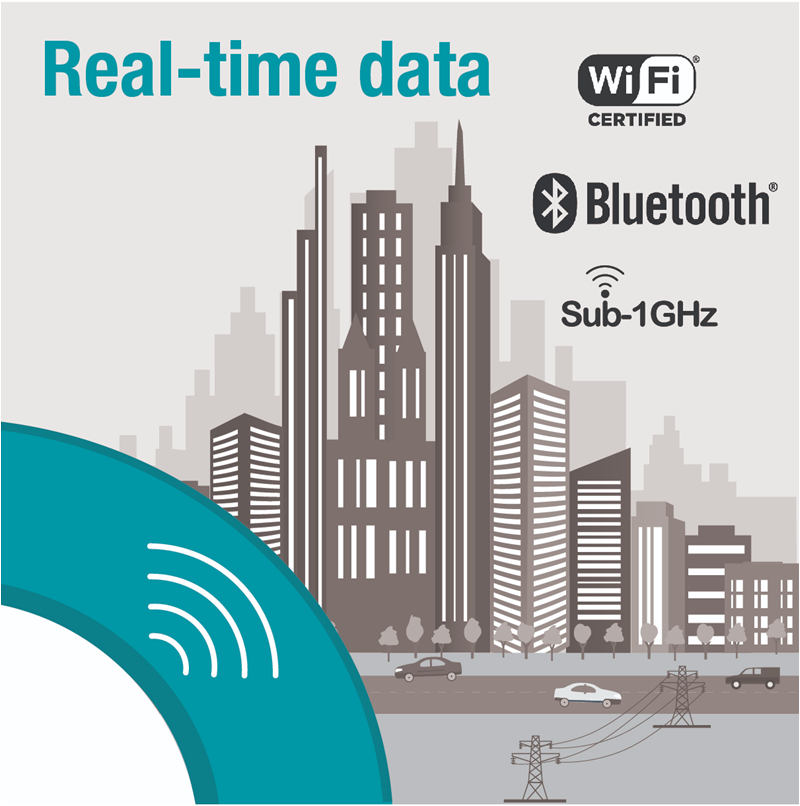SLYY148B january 2019 – april 2023
Real-time data, monitoring and control of the grid

Electric utilities face important challenges in key aspects of their business as a result of the ongoing and rapid transformation of the grid.
Conventionally, grid networks in cities relied on above-ground distribution with wires. This system will yield to power conduits dug down into the ground, because there is not space for more overhead lines in big cities, and because people do not like to see power lines over or in front of their homes.
In the past, utilities had fairly simple ways to find faults above ground: They sent out a maintenance truck to drive along the power line to discover a fallen power line, a tree hanging on a line or too much snow on a line. In all of these instances, the cause of the power outage was pretty obvious. But grid modernization allows for real-time communication, measurement and surveillance – and quick response and repair –when it is not possible to see underground failures.
The use of real-time data management has become more important than ever when it comes to connecting the utility grid system. The goal is to place data in the hands of those who can make the best use of it. Modern mobile devices are a readily available platform for data delivery and control of both smart grids as well as the multiple energy sources incorporating the solar photovoltaic panels that make up a microgrid. Wi-Fi® and Bluetooth® are obvious methods for wireless grid connectivity; if necessary, an intermediate gateway can be another option. TI’s Grid IoT Reference Design: Connecting Circuit Breakers and Sensors to Other Equipment Using Wi-Fi is designed for real-time asset monitoring in the smart grid. The main benefits of the reference design include:
- Real-time asset health monitoring (monitoring current, voltage and temperature levels through Wi-Fi® communications).
- Adding redundant, variable data-rate transfer capability for critical applications.
- Backup for wired communications within the substation.
- Improving response times for detecting faults.
- Reducing power downtime.
The reference design shows how integrating Wi-Fi is a viable solution for substation equipment and residential breakers that require high data rates and large bandwidth. Sub-1 GHz connectivity is another applicable wireless technology when transmitting data over a long range with low power consumption for substation and distribution automation, useful when multiple nodes (such as fault indicators) need to transmit data to one data collector for the formation of a star network. Both technologies are available through the SimpleLink™ family of wireless MCUs based on the foundational SimpleLink software development kit, promoting 100% code reuse and seamless transition between multiple wireless connectivity technologies.
The Grid IoT Reference Design: Connecting Fault Indicators, Data Collector, Mini-RTU Using Sub-1 GHz RF employs wireless Sub-1 GHz communication in a star network between multiple sensor nodes (in this case, fault passage indicators [FPIs]) and a collector using the TI 15.4 stack. This design is optimized for low-power consumption for short ranges (<50 m) using overhead FPIs and a data collector in distribution automation as an application scenario.
It also employs the CC1310 from TI’s SimpleLink family, which incorporates a Sub-1 GHz radio-frequency (RF) transceiver and an Arm® Cortex®-M3 MCU. The TI 15.4 stack configures beacon-mode communication over the U.S., European Telecommunications Standards Institute and China frequency bands. Current consumption data is available for a single-packet data transfer of 1 to 300 bytes at a 50-Kbps data rate by optimizing transmit power levels (0 to +10 dBm) and beacon intervals (0.3 s to 5 s).
As electric networks connect to renewable power sources with multiple feed-in points from wind turbines and solar panels, distribution becomes more complex. Increased automation is a defining feature with remote measurement, services and repairs, and requires real-time monitoring and control as well as high reliability. Network redundancy is of fundamental importance in these complex smart grids. This duplication of important components or functions enables systems to continue functioning in failure scenarios, decreasing network downtimes that might lead to property damage or even loss of life. Network redundancy can also enable workers to perform maintenance on a subset of the network without interrupting power delivery.
Ethernet is popular and readily available, based on the International Electrotechnical Commission (IEC) 61850 Ethernet standard for grid management. Redundancy protocols are a building block to add reliability and enable Ethernet as a management network for smart grids. IEC 62439-3 defines two architectures, parallel redundancy protocol (PRP) and high-availability seamless redundancy (HSR), for implementing zero-loss redundancy on wired Ethernet. Arm-based processors and MCUs integrate support for these protocols and the associated cut-through switching. With PRP, each node connects to two separate parallel local area networks (LANs).
Source nodes send two copies of each packet, one over each interface. The destination node receives a frame, accepts the first copy and drops the second frame. The destination node will always receive at least one packet with zero downtime, as long as either of the two networks is able to operate. The HSR ring provides the same level of redundancy as PRP, using a ring topology instead of two LANs.